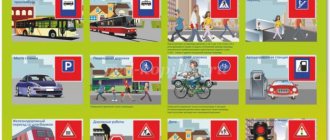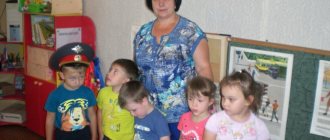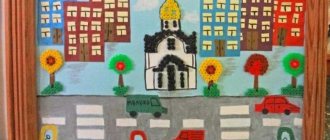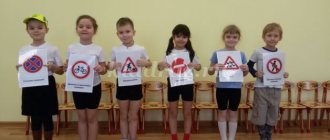Lesson on studying traffic rules “Road signs are our friends and always remember the rules of the street”
Program content of the lesson:
- teach children to distinguish road signs by color and shape;
- to form a system of knowledge about roads. signs and traffic rules;
- develop cognitive interests, logical thinking, memory, observation skills;
- cultivate discipline and organization;
- to form a culture of behavior on the street and road;
- increase the level of speech development.
Type of lesson: improving knowledge, skills and abilities.
Materials: a poster with an image of an intersection, road signs, envelopes with cut signs (according to the number of children, three types each), two drawings depicting two traffic situations with opposite meanings.
Teaching methods: dialogical, monologue presentation.
Teaching methods: explanatory, stimulating, informative.
Teaching methods: partially exploratory, practical, performing.
Methods of education: support and approval of moral feelings, assessments; creating problematic situations.
Methodological novelty: integration of various types of activities (traffic rules, logic, spatial orientation, practice of sensory perception in a didactic exercise).
Progress of the lesson
— Guys, do you like to walk on the street, in courtyards, and walk around the city? What danger could lie in wait on the street? To avoid danger, you must follow traffic rules. As soon as you go out into the street, you see multi-colored road signs all around you, the traffic lights are constantly changing colors, cars are racing, the asphalt is all lined with white lines. With the help of signs, traffic lights, road markings, the street talks to us. When you go out onto the street, onto the road, you become participants in traffic and are called pedestrians. There are sidewalks for you, and a wide roadway for drivers.
— Let's look at some road signs. They can be found on the street. They are of different colors and different shapes. What do you think the signs are for?
“With the help of these signs, the street talks to pedestrians and drivers so that we can protect ourselves and our neighbors and maintain health.
— All road signs are divided into warning signs, priority signs, prohibitory signs, prescriptive signs, special instructions signs, information signs, service signs, and plates.
— This sign of special instructions is “Pedestrian crossing.” It tells road users where to cross the road. This crossing point is also marked with white Zebra markings.
— This is a warning sign “Children”, triangular in shape with a red border. It is installed near schools and kindergartens. Drivers must be very careful.
— Among the road signs, the strictest are prohibitive ones. They are round with a red border. This sign prohibits drivers from moving - “No movement”. This prohibits riding a bicycle, but you can ride a bicycle in your hands. This one prohibits pedestrian traffic “Pedestrian traffic is prohibited.” Here the pedestrian is crossed out with a red line. Where do you think this sign might be? (Where a person may be in some kind of danger: at construction sites, at training grounds, where military exercises are conducted on military equipment, on highways with a dense flow of cars).
— And these are the mandatory signs “Bicycle path” and “Pedestrian path”. They are round, blue, the symbols themselves are white.
Service sign “Food station”. It is exhibited near cafes and canteens.
These are information signs “Overground pedestrian crossing”. Where is it installed? (It is installed where you can cross the roadway above it - on a bridge). And near the underground pedestrian crossing they install the following sign (in unison): “Underground pedestrian crossing.” By crossing the roadway underground, a pedestrian can avoid the danger of getting hit by a car.
- Now look at this poster. Shown here are roadways that intersect with each other and are called intersections. There are sidewalks, pedestrian crossings (zebra crossings), traffic lights, underground and overground pedestrian crossings. It also depicts houses, a school, a cafe and children who, when they go out into the street, become pedestrians, but there are no signs installed. Let's arrange them together (“Food station”, “Children”, “Pedestrian crossing”, “Underground and overground pedestrian crossings”). Now let's look at this boy, he is a student and he needs to get to school. Help him and show him a safe way to cross the roadway, following the traffic rules. (Calling the children, also help three more students; ask the children’s opinion if they agree with this decision).
Fizminutka
- And now we will all be cyclists. And, observing the rules of the road, we will ride, and these two road signs will help us with this. (Children call them in unison.) When I show the blue sign “Bicycle path”, you, lying on the carpet, pedal, and at this “No cyclists” - stop.
Working at tables
— Now you need to make road signs. You have envelopes on your tables containing cut parts of the signs. But first, listen to the poems, guess what signs they are about and find mistakes in them.
I want to ask about the sign. The sign is drawn like this: In a triangle, the guys are running as fast as they can somewhere. My friend says: “Children’s way here is closed!”
— What sign is the poem about, what is the mistake in it? Pour the cut signs out of the envelopes and make up the one mentioned in the poem. What sign did you collect, what is it called? What does it matter?
We were walking home from school, We saw a sign on the pavement: Blue circle, bicycle, There is nothing else. The friend thought a little and said: “There is only one answer - The sign says: the path leads straight to the bike shop.” A white triangle, in a blue square, A black pedestrian is walking along a zebra crossing. Apparently the path here is safe: Maybe there is an underground passage?
(Children complete the task, children are asked the same questions).
- Have you guessed what sign the poem is about? Sasha, what sign did you collect, what is it called?
Now let's look at two more pictures, which depict two different situations. Let's look at the first one. (Pedestrians cross the roadway at a pedestrian crossing when the traffic light is green). And on the second, children play with a ball right on the roadway. (Listen to the children’s comments and answers).
- And you guys too, follow the traffic rules, don’t play on the roadway. And in class you participated well, answered, and completed assignments.
Summarizing.
Author: Elvira Maratovna Sultanova, teacher at MBDOU kindergarten No. 19 “Milashkey”, Bugulminsky municipal district of the Republic of Tatarstan.
The article is published in the author's edition.
Class hour "Road signs"
Presentation "Road Signs"
PPT / 1.12 MB
Class hour "Road signs and their groups"
Target:
— create conditions for consolidating and expanding junior schoolchildren’s knowledge about road signs
Tasks:
introduce road signs and their groups.
develop the ability to independently use the acquired knowledge in everyday life.
Foster a sense of responsibility for your life and the lives of other people on the road by following traffic rules.
Equipment:
Computer, projector. — computer presentation; — illustrations of road signs made by children to decorate the board;
- colored circles (red, yellow, green) according to the number of children, signs with the words “Warning”, “Prohibiting”, “Service Signs”, “Prescriptive”, road signs cut into pieces for the game “Assemble a road sign”, postcards - reminders with traffic rules.
Planned results
Personal skills:
Manifest:
- realize your own achievements when mastering the educational topic.
- cultivate interest and respect for the general law of roads and streets;
— develop attention, activity, discipline, responsibility;
Meta-subject skills:
Cognitive:
— reveal the meaning of the concept “road alphabet” and justify your opinion;
- use acquired knowledge when completing a learning task.
Regulatory:
- complete a learning task using the rule;
—perform self-tests, mutual checks and mutual assessments when completing a learning task;
— correlate the set goal and the obtained result of the activity.
Communication skills:
— act according to the rules of cooperation, taking into account the positions of partners;
- formulate correct statements using terms;
- negotiate and come to a common decision when working in a group.
Subject Skills:
— introduce students to the rules of the road: crossing the street, playing in the yard;
- learn to understand traffic lights,
- introduce, remember and recognize road signs: pedestrian crossing, bus stop, bicycle path, children crossing the road;
- develop street behavior skills;
— expand students’ knowledge of traffic safety;
- be able to classify signs according to their purpose.
Class progress
Introduction (introductory speech by the class teacher)
Slides 2-4
- Look at these photographs - the streets of our city (3-4 photographs). Active movement of various types of transport; pedestrians going about their business; passengers at city transport stops, waiting for a trolleybus or bus - we see all this every day. You and I are also pedestrians on the road and passengers in transport.
Every year more and more vehicles appear on the roads of our city. Who on the roads helps us and car drivers move correctly and choose a safe route?
(children's answers: traffic lights, road signs and marks)
Karaoke for children MP4 / 22.97 MB
— Imagine that all the traffic lights in our city suddenly went out. And all the inspectors regulating traffic and road signs have disappeared somewhere. What consequences might there be? (Discussion of the issue).
— Caution and compliance with traffic rules by drivers and pedestrians is the basis for safe movement on the street.
— We devote our class hour to traffic rules.
The class teacher asks the children to take one circle and break into three teams by color: red, yellow, green. (In the future, the team that gives the correct answer to the questions or completes the task correctly receives points)
Main part.
Journey into the past
- Guess the riddle:
I blink my eyes tirelessly day and night,
I help cars and I want to help you. (traffic light)
- Guys, do you know what a traffic light is for? (children's answers)
— Who knows where and in what year the world’s first traffic light was installed?
(In 1868 in London) Slyad 5. — When and in what city was the first traffic light installed in Russia?
(In 1930 in Leningrad and Moscow) Slyad 6.
The traffic light got its name from a combination of two words: the Russian word “light” and the Greek word “foros” - to carry. A traffic light is the best friend of drivers and pedestrians. Let's remember all his signals and sing the song "Traffic Light".
Performance of the song “Traffic Light” - karaoke for children. Slide 7.
Road ABC
A trained student reads a poem
ABC OF THE CITY
The city in which you and I live can rightfully be compared to a primer.
With the alphabet of streets, avenues, roads, the city gives us a lesson all the time.
Here it is, the alphabet, - Above your head: Signs are hung along the pavement.
Always remember the alphabet of the city, so that trouble does not happen to you.
- What alphabet is talked about in the poem? (road signs)
All road signs can be divided into groups. They vary in shape and color.
View slides with road signs, read poems about these signs - Slides 8-23.
Road signs perform some task on the road. Signs in red triangles are called warning signs. (Plate with the word “Warning”)
"Children" sign:
There are children in the middle of the road, We are always responsible for them. So that their parent does not cry, Be careful, driver!
Slippery road sign:
This sign says sternly: “Very slippery road. Don’t joke with the road, don’t turn the steering wheel in vain!”
Road Works Sign:
Road works sign. Someone is fixing the road here. You will need to slow down, there are people on the road.
Wild Animals Sign:
Moose, wolves, and rhinoceroses roam here in the middle of the road. You, driver, don’t rush, Let the hedgehogs pass first!
– There are also red signs, round ones. Here is a “No entry” sign, and here is a “No traffic” sign. They prohibit, which means they are... prohibiting. (Sign with the word “Prohibiting”)
No movement sign:
This sign is very strict, since it is on the road. He tells us: “Friends, you can’t drive here at all!”
No entry sign:
The sign scares drivers and prohibits entry for cars! Don't try to rush past the brick!
Sign “Pedestrian traffic prohibited”:
No pedestrians walk here in rain or shine. The sign tells them one thing: “You are prohibited from walking!”
"No Bicycles" sign:
The sign looks strictly at everyone, It strictly forbids us to ride bicycles and their relatives - mopeds.
- But the signs are blue. What can the blue circle tell us? (Allows). Or rather, it prescribes, recommends. Such signs are called prescriptive. (Plate with the word “Prescriptive”)
Bicycle path sign:
This sign is like a red light, there is no way for cars here. The kingdom here is of bicycles, pedestrians and mopeds.
Pedestrian crossing sign:
There is a land crossing here, people walk all day long. You, driver, don’t be sad, let the pedestrian pass!
Sign “Underground pedestrian crossing”:
Every pedestrian knows about this underground passage. It doesn't decorate the city, But it doesn't interfere with cars!
"Go straight ahead" sign:
The sign tells us stubbornly: Just go straight!” But we won’t harm ourselves if we back up.
- And these are service marks. They tell us what services they can provide us. (Plate with the word “Service Marks”)
Food station sign:
If you need food, then come here. Hey driver, pay attention! Food station coming soon!
Gas station sign:
You can't get to the cafe and store without gasoline. This sign will tell you loudly: “There is a gas station nearby!”
First aid station sign:
If someone breaks their leg, doctors here will always help. They will provide first aid, and they will tell you where to go for further treatment.
Maintenance sign:
Ah ah ah! What a pity! Something suddenly broke with us. This sign tells us: “Here is machine-made Aibolit!”
— We met some of the signs, but there are many more. There are 233 characters in total, we will get to know them next time.
Game "Collect a road sign"
Students need to assemble a road sign, which is cut into several parts. After the team has been able to assemble a sign, it needs to be glued onto a piece of paper and determined what it means.
Summarizing
Traffic rules are the laws of streets and roads. Drivers and pedestrians are required to know these rules and follow them. The driver must know what awaits him ahead on the road. Road signs tell him this.
Reflection.
Slide 24.
— Where will we need the knowledge gained in class?
— What new did you learn in class today?
Calculation of points scored in teams. Rewarding teams (all students) with postcards with traffic rules.
Next, the class teacher invites the children to go outside and see what road signs there are near our school.
Going outside.
Resources used:
https://www.olesya-emelyanova.ru/index-stihi-dorozhnye_znaki.html
Three traffic lights. Didactic games, quizzes. M: Enlightenment, 1998
Guys! Always be careful and careful! Follow the traffic rules!
When leaving home or school on the street, remember:
You must always be an example in observing traffic rules and demand this from your comrades.
Cross the street along pedestrian paths and only when the traffic light is green, and where there is none, in the absence of nearby traffic.
Don't suddenly run out onto the road because of stopped vehicles, because... it blocks visibility and you could get hit by another car.
When waiting for a bus, trolleybus or tram, stand on the sidewalk or landing area.
Do not ride your bicycle on the street if you have not learned the rules of the road and, especially if you are under 14 years old.
Remember the kids. Having appeared on the street, they start dangerous games on the pavement. To save their life and health, take them off the road.
Topic 3. Road signs.
All signs are divided into eight groups according to their purpose. All groups have “telling” names. Warning signs - warn, prohibitory - prohibit, informational - inform, etc. The first thing you must learn is to understand which group the sign installed on the road belongs to. And the authors of the Rules took care of this, simplifying the recognition process as much as possible.
A person associates attention with a triangle, and it is no coincidence that almost all warning signs are triangular in shape. These signs seem to shout to us: “There is danger ahead! Be careful!" You will also easily learn to distinguish traffic priority signs from all others. Firstly, there are few of them, and all of them (with the exception of two) are installed only before intersections. Secondly, they are unmistakably identified either by their symbols or are distinguished by the uniqueness of their form.
For example, sign 2.5 “Moving without stopping is prohibited” is the only octahedron in the entire family of symbols. Yes, and sign 2.4 “Give way” is also an original - it is the only triangle placed “upside down” (all other triangular-shaped signs stand as expected - on their base).
A person associates a ban, and indeed any restriction, with a circle. That is why prohibition signs are round in shape. At the same time, the prohibition signs have a strict appearance - black symbols on a white background, and even a red “screaming” rim. Of course, they forbid it! And what they prohibit is depicted on the sign. Sign 3.19, for example, only prohibits turning around, and everything else is welcome. Mandatory signs are also round in shape and therefore also impose restrictions on your movement. For example, sign 4.1.1 instructs all drivers: “Move straight!” Moreover, only directly and nowhere else. Prescriptive signs depict not what is not allowed, but what is allowed. Therefore, unlike prohibitory signs, their symbols are white and the background is blue.
"Signs of special regulations"
and “Information signs” provide the driver with various important information. In the first case - more strict, in the second - less strict.
For example, sign 5.5
informs the driver that he is driving on a one-way road, and this imposes some restrictions on his behavior. A one-way road has its own (special!) traffic mode, and the sign reminds the driver of this.
Sign 6.4
it simply informs the driver that he can park in this place with impunity.
A person associates information with a piece of paper, with a poster, with a screen, finally. That is why all these signs are either square or rectangular in shape. The background color can be different: blue, white, green or yellow. And this matters, which we will talk about a little later.
As for the “Service Marks”, they are absolutely all rectangular in shape, with a blue background, and it is not difficult to understand what is depicted on them. Finally, "Tablets". Almost all plates, unlike signs, are not color, but black and white. Plates are not used separately from signs. They are always adjacent to some sign and complement or clarify its action. For example, sign 8.5.2 “Working days”, posted separately on the road, looks like a misunderstanding. However, if you hang the same sign, for example, under sign 3.19 “U-turn is prohibited,” then this combination takes on a very specific meaning – “U-turn is prohibited on weekdays.” On Saturday, Sunday and holidays this restriction does not apply, you can turn around.
In addition, the driver (if he wants to understand the text of the Rules) needs to know that the sign can be:
– main,
– preliminary,
- repeated,
– duplicating.
These terms are not defined in the Rules themselves, but what is stopping us from reading the current GOST R 52289 - 2004 “Technical means of organizing road traffic. RULES FOR THE APPLICATION OF ROAD SIGNS, MARKINGS, TRAFFIC LIGHTS, ROAD FENCES AND GUIDING DEVICES.”
GOST R 52289 – 2004. Section 3 “Terms and definitions”.
Clause 3.3. Primary sign – a sign the need for installation of which is determined by road conditions in accordance with the requirements of this standard.
Before the intersection there is a sign 2.4 “Give way”. Traffic organizers considered that the installation of such a sign here is “ determined by road conditions in accordance with the requirements of this standard”
and, therefore, according to GOST, this is the most
basic sign.
But this is
a preliminary sign!
Now drivers are informed that after 300 meters the main sign 2.4 “Give way” will be installed.
GOST gives the following definition:
Advance sign
– a sign installed before the main sign and warning drivers about an upcoming change in traffic mode or object, information about which is contained on the main sign
.
But it may be so - the main sign
(the need for installation of which is determined by road conditions in accordance with the requirements of this standard), followed by
a repeat sign
(and even with a sign clarifying the effect of the main sign).
GOST gives the following definition:
A repeated sign
is a sign installed behind the main sign and confirming its information.
Finally, what is
a duplicate sign?
Duplicate sign
installed on the same cross-section of the road as the main sign. A duplicate sign can be installed above the road, or placed on the dividing strip, or even on the left side of the road (if there are no more than two lanes in the oncoming direction).
GOST gives the following definition:
A duplicate sign
is a sign installed in the same cross-section of the road as the main sign, which serves to increase the reliability of information perception by traffic participants.





